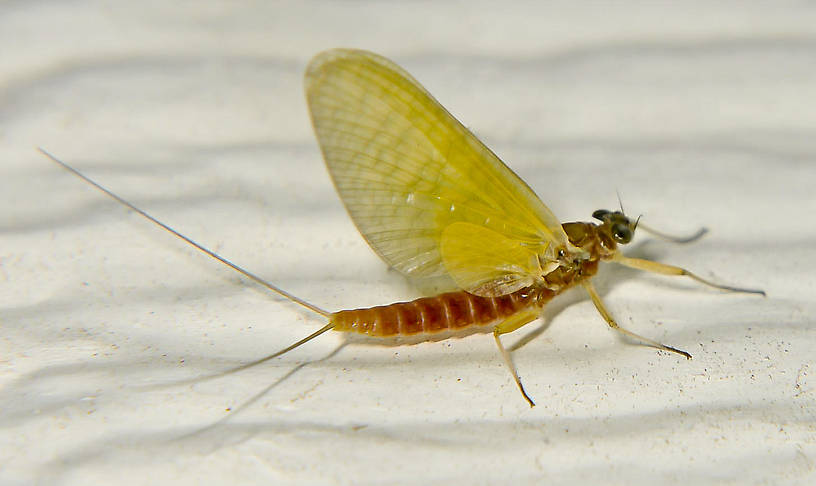
Hex Mayflies
Hexagenia limbata
The famous nocturnal Hex hatch of the Midwest (and a few other lucky locations) stirs to the surface mythically large brown trout that only touch streamers for the rest of the year.
Featured on the forum

This one seems to tentatively key to Holocentropus, although I can't make out the anal spines in Couplet 7 of the Key to Genera of Polycentropodidae Larvae nor the dark bands in Couplet 4 of the Key to Genera of Polycentropodidae Larvae, making me wonder if I went wrong somewhere in keying it out. I don't see where that could have happened, though. It might also be that it's a very immature larva and doesn't possess all the identifying characteristics in the key yet. If Holocentropus is correct, then Holocentropus flavus and Holocentropus interruptus are the two likely possibilities based on range, but I was not able to find a description of their larvae.

Troutnut is a project started in 2003 by salmonid ecologist Jason "Troutnut" Neuswanger to help anglers and
fly tyers unabashedly embrace the entomological side of the sport. Learn more about Troutnut or
support the project for an enhanced experience here.
Western Ginger Quills
Like most common names,"Western Ginger Quill" can refer to more than one taxon. They're previewed below, along with 5 specimens. For more detail click through to the scientific names.
Mayfly Genus Ecdyonurus
These are often called Western Ginger Quills.
This fairly new genus holds some Western species that used to be in Nixe and were in Heptagenia before that. They are mentioned in books by those generic names. Ecdyonurus simpliciodes is especially important.
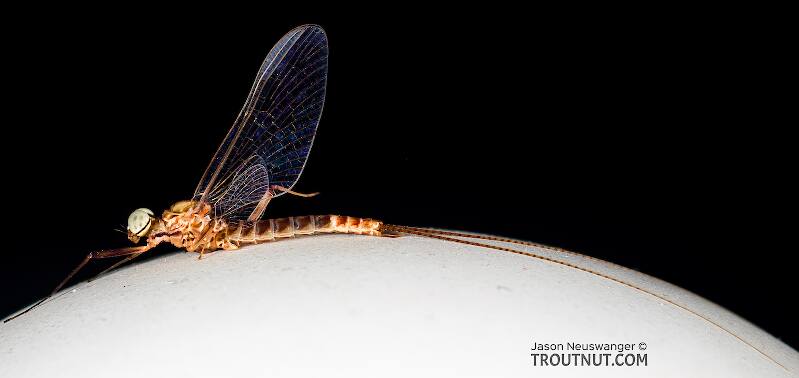
This one was very puzzling to identify. It's clearly Heptageniidae. It keys pretty easily to couplet 58 in Merritt, Cummins, & Berg 5th Edition, but that's where things get tricky.
58: Male penes distinctly L-shaped; Segment 1 of foretarsi usually 1/3 to 2/3 the length of segment 2
58': Males penes not distinctly L-shaped; Segment 1 of foretarsi usually 1/5 to 1/2 the length of segment 2
The characteristics conflict here, as I'd say the penes ARE L-shaped, but the fore tarsal ratio is less than 1/3. Maybe the weasel word "usually" allows for that, and it's some kind of Stenonema, for which I'm not aware of any records in Montana, let alone western Montana.
Going by the tarsal ratio and assuming it's not Stenonema, everything in couplet 60 points to Afghanurus: contiguous compound eyes, genitalia similar to fig 13.222 in MC&B, and weakly developed basal costal crossveins in the forewings. But I looked up the original descriptions of the three Afghanurus species, and the body sizes (flowersi 5-7 mm, inconspicua 4 mm, joernensis 6-7 mm) are way below this one's 10 mm.
This led me to notice that the closely related Ecdyonurus is not included in the key at all, so I checked the descriptions of those species and found that Ecdyonurus criddlei fits very well: the color of the legs, the markings on the tergites and sternites, the short fore tarsus and ratios of the segments, etc. It was originally described as 7 mm, smaller than the 10 mm body of this specimen, but synonyms have been described with larger sizes including wing lengths up to 11 mm for females for Heptagenia salvini.
This specimen was found with a female nearby, which I think is probably the same species, although it is difficult to be certain.
58: Male penes distinctly L-shaped; Segment 1 of foretarsi usually 1/3 to 2/3 the length of segment 2
58': Males penes not distinctly L-shaped; Segment 1 of foretarsi usually 1/5 to 1/2 the length of segment 2
The characteristics conflict here, as I'd say the penes ARE L-shaped, but the fore tarsal ratio is less than 1/3. Maybe the weasel word "usually" allows for that, and it's some kind of Stenonema, for which I'm not aware of any records in Montana, let alone western Montana.
Going by the tarsal ratio and assuming it's not Stenonema, everything in couplet 60 points to Afghanurus: contiguous compound eyes, genitalia similar to fig 13.222 in MC&B, and weakly developed basal costal crossveins in the forewings. But I looked up the original descriptions of the three Afghanurus species, and the body sizes (flowersi 5-7 mm, inconspicua 4 mm, joernensis 6-7 mm) are way below this one's 10 mm.
This led me to notice that the closely related Ecdyonurus is not included in the key at all, so I checked the descriptions of those species and found that Ecdyonurus criddlei fits very well: the color of the legs, the markings on the tergites and sternites, the short fore tarsus and ratios of the segments, etc. It was originally described as 7 mm, smaller than the 10 mm body of this specimen, but synonyms have been described with larger sizes including wing lengths up to 11 mm for females for Heptagenia salvini.
This specimen was found with a female nearby, which I think is probably the same species, although it is difficult to be certain.
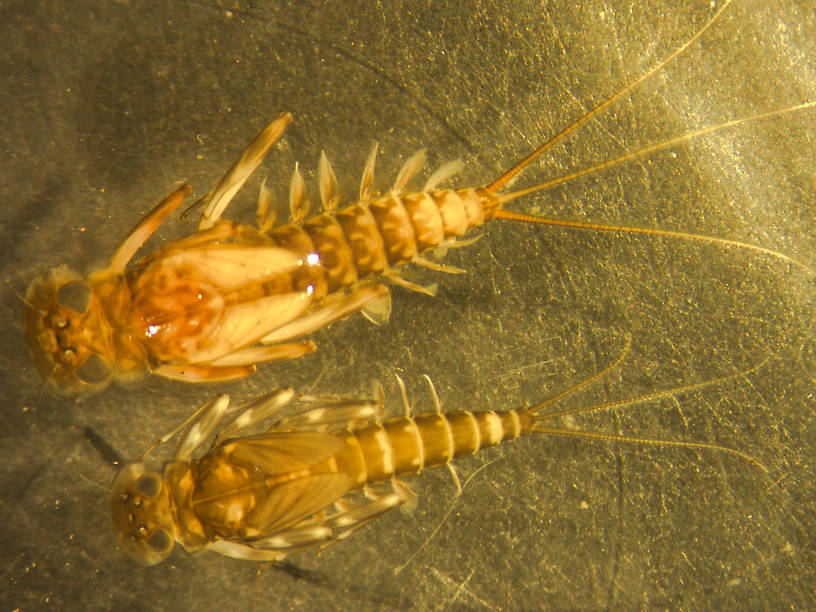
This is an interesting Heptageniid mayfly since in western Montana it is only found in cold lakes, especially those in Glacier National Park.
See 1 more specimen...
Mayfly Species Cinygmula reticulata
These are sometimes called Western Ginger Quills.
Cinygmula reticulata is probably the second most important species of Cinygmula behind Cinygmula ramaleyi, perhaps because the waters where it can be found in good numbers are often more remote. They have been reported as abundant in many high country streams of the Southern Rockies as well as the High Sierra's Eastern slope. An obvious difference in their coloration may be the easiest way to tell them apart. Cinygmula ramaleyi is more somber with a brownish body and dark gray wings and is often confused with the similar sized and colored Ephemerella tibialis, in spite of the difference in tail counts. Cinygmula reticulata on the other hand is a bright cinnamon dorsally with pale creamy legs and pale wings that are often a brilliant canary yellow. This is one of North America's most beautiful mayflies.
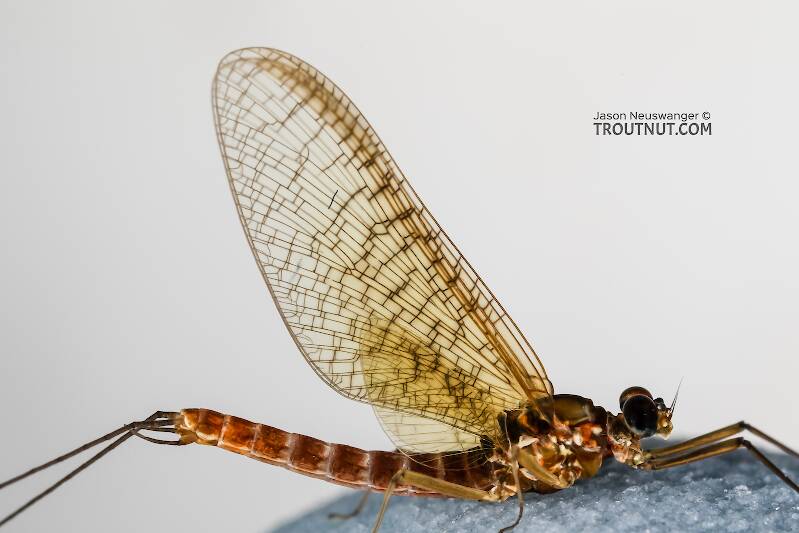
The lengths of the wing and body, measured with a caliper, are both 8 mm.
Keys in Needham's 1935 Biology of Mayflies point to either Cinygmula reticulata or Cinygmula gartrelli. It seems to have crossveins in costal half of forewing only, slightly margined with brown and wings tinged with amber at base and along costal margin of both wing (gartrelli) as opposed to all crossveins of both wings faintly but broadly margined with pale smoky and wings entirely amber-tinged (although there is a slight amber tinge throughout, just more pronounced in places) as in reticulata. However, wing length reported for reticulata (9 mm) is closer to this specimen than gartrelli (10 mm). Ventral median marks are supposed to be "traces" for reticulata and "present" for gartrelli. Descriptions for both species involve semi-hyaline anterior abdominal segments not present on my specimens. Distribution records suggest reticulata lives nearby, so I'm going with that, but I can't confidently rule out gartrelli.
Keys in Needham's 1935 Biology of Mayflies point to either Cinygmula reticulata or Cinygmula gartrelli. It seems to have crossveins in costal half of forewing only, slightly margined with brown and wings tinged with amber at base and along costal margin of both wing (gartrelli) as opposed to all crossveins of both wings faintly but broadly margined with pale smoky and wings entirely amber-tinged (although there is a slight amber tinge throughout, just more pronounced in places) as in reticulata. However, wing length reported for reticulata (9 mm) is closer to this specimen than gartrelli (10 mm). Ventral median marks are supposed to be "traces" for reticulata and "present" for gartrelli. Descriptions for both species involve semi-hyaline anterior abdominal segments not present on my specimens. Distribution records suggest reticulata lives nearby, so I'm going with that, but I can't confidently rule out gartrelli.
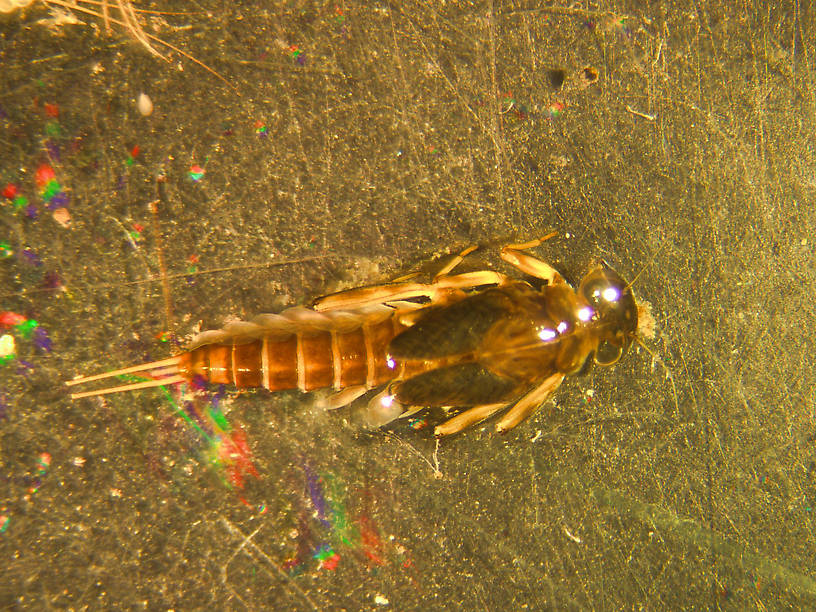
I collected several live specimens of nymphs and reared them to the imago stage. They were C. reticulata. The interesting thing is they were collected in May and were emerging along with Rhithrogena (March Brown). This seems to be an overlooked hatch since in some rivers it emerges very early, before runoff.
Mayfly Species Ecdyonurus simplicioides
These are sometimes called Western Ginger Quills.
This is an important Western hatch.


